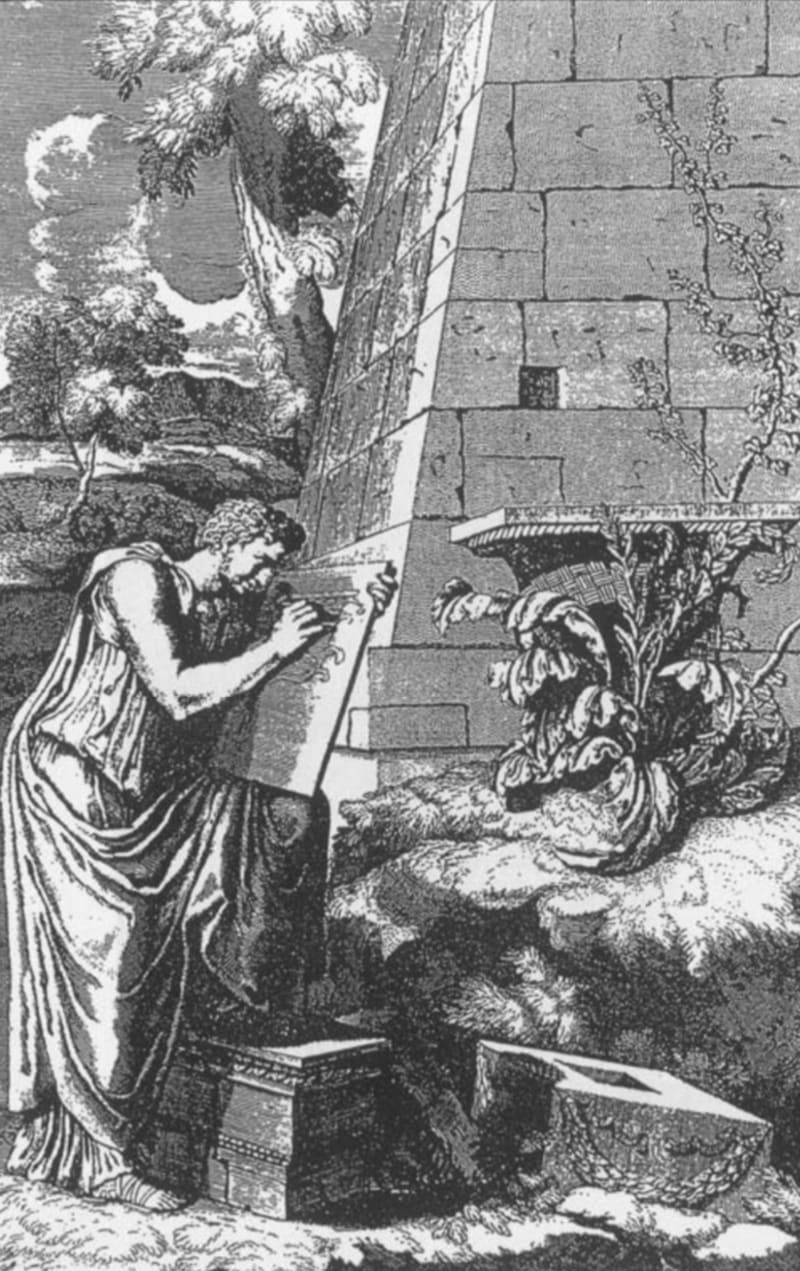Acanthus leaves in a basket

The three principal ‘orders’ of classical architecture – Doric, Ionic and Corinthian - are readily distinguished by the capitals on their columns. Of these, the Corinthian capital is the most elaborately decorated. There are many variants, but the basic form is that of a cylindrical basket with an acanthus plant growing through the basketwork. The leaves of Mediterranean species of acanthus are spiky and deeply cut. There are spiral *volutes *above the leaves, and there can be *palmettes *– motifs resembling fans of palm leaves – between the volutes. On top is a flat slab with curving edges, so that the four corners are pointed.

The Roman engineer Vitruvius tells a fable about the origin of the design. A young maiden of Corinth became ill and died. Her nurse collected a few of her possessions in a basket, and placed the basket on the girl’s tomb, covering it with a roof tile to protect the contents. “The basket happened to be placed just above the root of an acanthus. The acanthus root … when springtime came round put forth leaves and stalks in the middle.” Pressed down by the weight of the tile, the uppermost stalks were curved into spirals. The sculptor Kallimachos passed by, was delighted, and designed columns for the Corinthians based on what he saw. The 17th century drawing by Roland Fréart de Chambray at the head of this article imagines the scene.
The basic design has offered endless opportunities for elaboration and variation. Roman versions carried rosettes. There were Indo-Corinthian capitals in the north-west of India with little figures of Buddha sitting among the acanthus. The example illustrated is in the Musée Guimet in Paris, and dates from the 3rd or 4th century AD. In the Renaissance the revived Greek version became standardised according to rules laid down in editions of Vitruvius and treatises by leading architects. But in the 19th and 20th centuries a certain freedom was regained.

Native species or typical crop plants were substituted for acanthus. The English architect William Donthorne devised an ‘agricultural order’ based on turnip and mangelwurzel leaves. Benjamin Latrobe, architect of the U.S. Capitol in Washington DC used Corinthian-type capitals featuring corncobs for the vestibule of the Supreme Court, and made other designs based on tobacco leaves, and magnolia flowers. These are sometimes called ‘nonce orders’, specially invented for use on just one occasion.

The Oxford Museum of Natural History, opened in 1860, has an arcade surrounding the central hall whose columns, made from the different varieties of British stone, are a lesson in geology. The capitals on these columns teach a parallel lesson in botany: they are Corinthian in spirit, but are decorated with carvings of British flowers. The sculptors were from Ireland: the brothers James and John O’Shea and their nephew Edward Whelan, brought in by the architects Woodward and Deane, and enthusiastically encouraged by the critic John Ruskin. Fresh plant specimens were brought from the University’s Botanical Garden for the carvers to work from. The new Rialto Fish Market in Venice of 1907 was designed by the painter and sculptor Cesare Laurenti and the architect Domenico Rupolo. The capitals of the columned hall carry many motifs including boats, flowers, the sun and moon, and self-portraits of the designers; but the majority depict the fishes and crustaceans on sale below .

Osbert Lancaster in his cartoon history of architecture *Pillar to Post *has two almost identical drawings of pompous neo-classical architecture in Nazi Germany (‘Third Empire’) and the Soviet Union (‘Marxist Non-Aryan’). The only difference between the buildings is in the great rows of columns, which in the Soviet case have no capitals. As Lancaster says, the Soviet architect has the habit “of eschewing the use of the capital on ideological grounds.” In truth, as the architectural historian Adrian Forty points out, classical capitals were one of the few places where Soviet architects had some licence to design what they pleased.
Vitruvius was writing in the first century BC, some 350 years after the Corinthian capital was introduced, and his story reads like a romantic invention. The classical archaeologist David Scahill thinks that there may, nevertheless, be some germs of truth in the tale. The acanthus plant was traditionally associated with burials, and its leaves appear on earlier funerary monuments. Kallimachos did indeed work in Corinth and was known for his metalwork – in which the city specialised - as well as his carving. There is some evidence of Ionic capitals being made from bronze in the 5th century BC. Scahill suggests that Kallimachos might have made a new design of acanthus leaves in bronze to be attached to stone columns, perhaps for a sanctuary or a building housing a tomb, and offers a drawing of what this might have looked like. As Scahill says, whether Vitruvius’s story is true or not, the invention of the Corinthian capital was “intertwined with funerary customs, Corinth and bronze working.”
Vitruvius, Ten Books on Architecture, trans Morris Hicky Morgan, Harvard University Press 1914, Book IV, Chapter 1, sections 9 and 10
David Scahill, ‘The origins of the Corinthian capital’ in Peter Schulz and Ralf van den Hoff, eds, Structure, Image, Ornament: Architectural Sculpture in the Greek World, Oxbow Books, Oxford 2009 pp.40-53